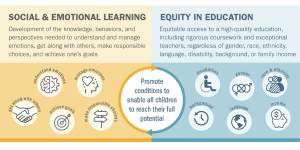SEL Is Important in Developing Equitable Learning Environments
SEL is a Tier 1 or universal support within a multi-tiered system of support (MTSS), providing assets and supports to all students to meet their social, emotional, and academic needs. A key tenant of SEL within an MTSS framework is the formation of positive relationships among teachers and students, which supports the development of a positive learning environment and the conditions that may help reduce the opportunity gap that exists within U.S. schools.
Connection Between Learning Environments and SEL
School climate and SEL are intertwined, interdependent, and mutually beneficial: students and staff in a school need to have social and emotional competencies to create a positive social environment, and positive school climates create conditions that help students develop social and emotional competencies. For example, students are more likely to learn from teachers who are caring and culturally responsive, and who model good social and emotional competencies. Similarly, students’ social and emotional skills can contribute to their safety and their ability to meet academic demands and effectively participate in all forms of learning.
SEL as One Way to Reduce the Opportunity and Achievement Gap
In a recent paper by the American Enterprise Institutes and the Brookings Institute, the authors identified SEL as one of the key strategies that educators can take to help reduce the opportunity gap between those in high-need areas and those who are not. For example, Gregory and Fergus note that many schools and districts are using SEL as a strategy to reduce discipline disparities in schools, and using SEL as a more proactive approach in discipline instead of exclusionary disciplinary practices. In other words, SEL is being used as a way for educators to change practice and for students to develop skills, affording teachers and students more opportunities to form more meaningful relationships.
“spend time to gain time.” When students develop the social and emotional skills necessary to engage in school, classrooms experience more time on task, students are able to regulate their own behavior to meet expectations, and teachers are using their social and emotional skills to create environments that motivate and engage students.
Ensuring SEL Supports Equity
Although SEL has potential as a tool to help reduce the opportunity gap, Gregory and Fergus caution that SEL should be implemented in a manner that ensures it supports skill development in a culturally responsive way. According to the authors, we need to pay attention to two things with regard to SEL programs and practices:
Ensure that notions of cultural differences are referenced and discussed as SEL programs and practices are implemented. To do this, educators consider the ecological conditions that affect equity, including the quality of instruction, types of behavior management strategies used, and overall context in which the student learns. In addition, educators can manage their expectations about which behaviors they expect students to exhibit when they are expressing a specific social and emotional competency. Educators can remember that there is no one right way to express a particular social and emotional skill. It is important to create conditions necessary to promote adult social and emotional competencies in order to translate programs and practices effectively to students.
Videos
Reflection
- What are some strategies you will take to ensure your SEL efforts support an equitable learning environment?
- What current conversations do you and your colleagues have about cultural differences? What action steps can you take to further those conversations? For example, do the adults in your building feel comfortable talking about race? Can everyone in your building discuss challenging issues with respect and an openness to learn?
References
American Enterprise Institutes & Brookings Working Group on Poverty and Opportunity. (2015). Opportunity, responsibility and security: A consensus plan for reducing poverty and restoring the American dream. Washington, DC: Author. Retrieved from https://www.brookings.edu/wp-content/uploads/2016/07/Full-Report.pdf
Business Roundtable. (2014). Closing America’s skill gap: A Business Roundtable vision and action plan. Washington, DC: Author. Retrieved from https://businessroundtable.org/sites/default/wp-content/uploads/blogs.dir/118/files/reports/BRT-SkillGap.pdf
Gregory, A., & Fergus, E. (2017). Social and emotional learning and equity in school discipline. The Future of Children, 27, 117–136. Retrieved from https://www.wallacefoundation.org/knowledge-center/Documents/FOC-Spring-Vol27-No1-Compiled-Future-of-Children-spring-2017.pdf
Jennings, P. A., & Greenberg, M. T. (2008). The prosocial classroom: Teacher social and emotional competencies in relation to student and classroom outcomes. Review of Educational Research, 79.

